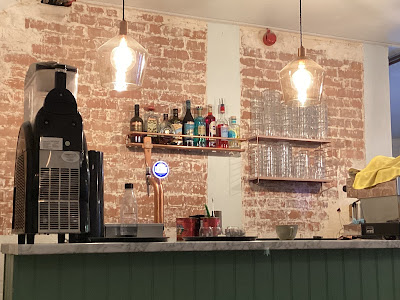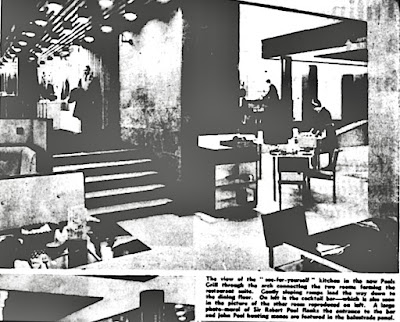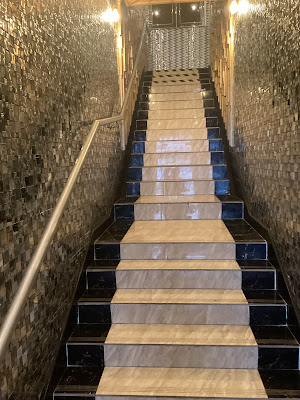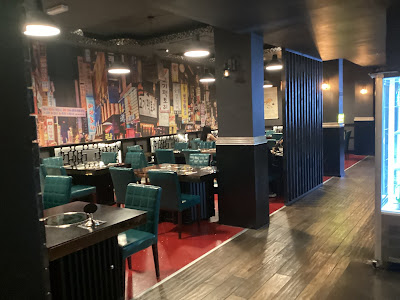Monday, 30 September 2024
432.Orelle.
431. Trentina.
The Good Food Guide added Trentina, an Italian-style restaurant located in Mary Street in the Jewellery Quarter, to its list of recommended restaurants as a ‘local gem’ on 4 August 2024. It described the restaurant as, “a truly local diamond, a cheerfully informal addition to Birmingham’s Jewellert Quarter scene. Inside it looks and feels sparsely contemporary”. The Guide goes on to say that “Here you will find big flavours on a short menu that leans heavily on the pasta roller….”.
It’s always difficult to find somewhere to eat on Sunday in the city centre but Trentina opens then and so, off I went. Autumn was well and truly entrenched and the continuing rain that had infested us for months coupled itself with a greyness worthy of Gandalf but Trentina was pleasingly easy to find, on the corner of Mary Street and Caroline Street, in the very heart of the Colmore family names system of roads, and was warm and welcoming on arrival, both from the front of house staff and the restaurant’s heating system.
I sat opposite the bar on a not terribly comfortable wooden banquette but as my lower body gradually accustomed itself to the vaguely masochistic seating I had chosen, the discomfort was gradually dispelled by a pleasing gin and Sicilian lemon tonic and a perusal of the promising menu. I discussed the options with the helpful and pleasant front of house young lady and opted for nduja and mozzarella arancini and then the pleasingly decorous mafaldine ribbon pasta with pork shoulder, finely chopped leek all enlivened by sofrito.
Rating:- 🌛🌛🌛🌛
Sunday, 29 September 2024
430. The Burlington.
The Burlington - that is - the restaurant in the Burlington Hotel in Stephenson Street, has the distinction of being the first Birmingham hotel to be mentioned in the newly revived Michelin Guide in 1974. Admittedly this was by virtue of its first letter’s position in the alphabet as it was featured alongside Lorenzo, La Capanna, Lambert Court, the Danish Food Centre, Royal in Sutton Coldfield and Manor House which was actually in West Bromwich.
I have never eaten at The Burlington but heard a good report of the food served there a few months ago and when I was invited to a dinner there I was pleased to accept mainly because I wanted to go to dine at this landmark restaurant in Birmingham’s dining out history.
The Burlington was included in the Michelin Guide from 1974 to the 1979 edition and has not appeared in those august pages since then and so I was expecting to be eating in a fairly middle of the road, reasonably good quality location. This was a moderately priced banquet attended by a couple of hundred diners or so and so I could not expect dishes to be exhilaratingly original or finely presented to any great degree. My expectations by and large were met.
The Burlington Hotel, long known as The Midland Hotel was bought by Isaac Horton in 1871 and developed in a style very similar to and predating his magnificent Grand Hotel which opened in 1875 on Colmore Row. The hotel was particularly attractive to travellers as it is located a few yards across Stephenson Street from New Street Station. A guidebook to Birmingham published in 1894 noted that the Midland Hotel’s restaurant served a “Hot luncheon 1 to 3PM 2/6d Table d’hôte 6 to 8PM 4/-“. Although the first series of Michelin Guides to Great Britain (1911-14 and 1922-31) with blue covers listed The Midland among its recommended hotels in Birmingham there were no details by which to judge the food on offer there.
For almost 40 years (dating back to the roaring twenties when American-style cocktails were all the rage and Hollywood-made movies were gripping the post-war generation) until the 1960s, the Midland was home to the American Bar and Snack Bar but this dining facility was considered to be outdated and was replaced by the Peel Grill (after the Tamworth MP Sir Robert Peel who founded the Metropolitan Police and the Conservative Party - the hotel by then neighboured Burlington Arcade which previously had been Peel’s Passage used as a shortcut by the local police officers otherwise known as Peelers). A report in the Birmingham Post published 6 May 1963 described the opening of Peel’s Grill in detail and included the information that the 84 seater restaurant had what it called “a see-for-yourself kitchen” whereby the diners could dine and watch the activities taking place in the kitchen at the same time - clearly a modern equivalent of the now almost universal ‘open kitchen’.
The photographs in The Post show a decor which was very much cutting edge Sixties - there was a cocktail bar at the entrance of which was a large ‘photo-mural’ of Sir Robert Peel and there were hunting scenes on the John Peel (no relation) theme “featured in the balustrade panel” (presumably someone had confused the two Peels and ordered artwork for the bar which just happened to feature both of them and it was question of using what had been bought).
The then general manager of both the Midland and The Grand, a Mr R Clemow, was quoted by The Post as saying,”We felt that the existing American Bar and snack bar - though they had served agoodpurpose for a number of years - were a little out of date in view of today’s trends in eating. The accent today seems to be more on grills and griddles rather than speciality dishes - we want to provide for people such as the businessman, the personal shopper or the younger people who want a satisfying meal at a reasonable charge. As the city centre develops and extends, we shall look to a wider clientele for evening patronage….”
In its heyday The Midland was host to celebrities such as Laurel and Hardy, Richard Burton and Peter O’Toole and Annunzio Mantovani, the orchestra conductor and composer, started his career there in 1924 working in a string quartet. In 1968, Enoch Powell MP delivered his “Rivers of Blood” speech at the hotel. The Back Room bar, where these celebrities may have been seen, was the source of some wonderful menus such as the following from the 1920s -
The Midland was renamed as The Burlington in 1996 after refurbishment had been carried out and its full name now is the McDonald Burlington.
So, even if the food was going to be unremarkable, the location was thrilling bursting with exciting Birmingham gastronomic history.
To be fair, the food was unremarkable - on par for a banquet meal in a restaurant with no present particularly distinguished culinary reputation. The service was excellent, the waiters smartly turned out, polite and efficient and the location itself spacious. The portions were generous and the food pleasing enough.
I chose the mackeral paté starter. This was very pleasant and reasonably presented. The mackeral flavour was not too overpowering and the accompanying ribbons of pickled cucumber and sweet earthy baby beetroot balanced the fish nicely and the finely sliced crispy Melba toast gave the dish all the texture it needed. The mild horseradish cream split fashionably with a green oil of some sort or the other made it a well rounded dish.
Monday, 9 September 2024
427. Itaewon.
I am not a Korean food aficionado; to be truthful my experience of the cuisine is ultraminimal though not entirely absent.
I saw some article or the other quite recently about Itaewon, a Korean restaurant in Station Street, opposite New Street Station, next door to the historic Old Repertory Theatre and two buildings down from the now closed but famous Electric Cinema. The Old Rep is said to have been the first repertory theatre to be opened in Britain and the Electric is said to have been the oldest surviving cinema in the UK. Venerable neighbours indeed.
I had completed a 2 hour walking tour dedicated to the buildings of Station Street and Smallbrook Queensway and finding myself in Station Street once more I seized the day and opted to have an exotic late Sunday lunch at Itaewon. When I entered the restaurant I discovered a colourful, small dining area with seating for 18 people and a small bar at the end furthest from the door gayly decorated with a slogan in pink fluorescent lighting with the inscription, “Choose your own adventure”. I was greeted immediately on arrival and seated comfortably next to the bar and the extensive menu was handed to me. The very helpful and friendly East Asian waiter was delighted to answer my questions about the menu and I learned a lot about Korean dishes and drinks in a remarkably short time.
News.
On 28 August 2024 the Michelin Guide announced that Albatross Death Cult was one of six British dining establishments to be included in its August list of recommended restaurants. In my opinion this might be the surprise new Michelin star for Birmingham come next year’s announcements by Michelin but then again, who can predict what the Michelin inspectors will come up with given the as ever quirky nature of their astral donations?
























































